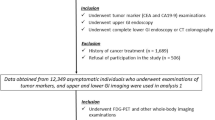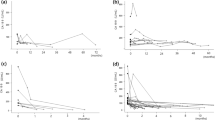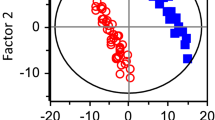Abstract
The aim of this study was to assess by a stepwise multivariate discriminant analysis the value of four current serum tumour markers - carcinoembryonic antigen (CEA), carbohydrate antigen (CA) 50 and CA 242 and tissue polypeptide antigen (TPA) - and a new serum tumour marker, tissue polypeptide specific antigen (TPS), in the diagnosis of pancreatic cancer. The serum values were measured in a prospective series of patients with jaundice, with unjaundiced cholestasis and with a suspicion of chronic pancreatitis or a pancreatic tumour (n = 193). There were 24 patients with a cancer of the pancreas and two patients with a cancer of the papilla of Vater in this series. Our results showed that CA 50 (P < 0.001) and TPA (P < 0.01) were the best marker tests in predicting pancreatic malignancy. Also, the TPS (P = 0.07) and CA 242 (P = 0.08) tests showed marginally significant independent discriminating power, while the CEA test did not (P = 0.12). In order to sum up the contributions of different markers, a diagnostic score (DSI) was developed. The discrimination function was: DS1 = CA 50 x 1.75 + TPA x 0.62 + TPS x (-0.37) + CA 242 x (-1.21). The sensitivity of DS1 in detecting pancreatic cancer was 36% with a specificity of 90% and an efficiency of 82%. When the combination of CA 50 and TPA was used as a test, the discrimination function (DS2) was: DS2 = CA 50 x 0.69 + TPA x 0.67. The sensitivity of DS2 was 44% with a 88% specificity and an efficiency of 82%. According to this analysis, the further advantage gained by a computer-aided scoring system seems to be limited, since despite the considerably high specificity and efficiency its sensitivity remained low. In the present analysis the best combination in diagnosing pancreatic cancer was the combination of CA 50 and TPA.
This is a preview of subscription content, access via your institution
Access options
Subscribe to this journal
Receive 24 print issues and online access
$259.00 per year
only $10.79 per issue
Buy this article
- Purchase on Springer Link
- Instant access to full article PDF
Prices may be subject to local taxes which are calculated during checkout
Similar content being viewed by others
Author information
Authors and Affiliations
Rights and permissions
About this article
Cite this article
Pasanen, P., Eskelinen, M., Partanen, K. et al. A prospective study of serum tumour markers carcinoembryonic antigen, carbohydrate antigens 50 and 242, tissue polypeptide antigen and tissue polypeptide specific antigen in the diagnosis of pancreatic cancer with special reference to multivariate diagnostic score. Br J Cancer 69, 562–565 (1994). https://doi.org/10.1038/bjc.1994.102
Issue Date:
DOI: https://doi.org/10.1038/bjc.1994.102
This article is cited by
-
Landmarks in pancreatic cancer studies
Cancer Cell International (2022)
-
Serum biomarkers for improved diagnostic of pancreatic cancer: a current overview
Journal of Cancer Research and Clinical Oncology (2011)
-
Circulating blood group related carbohydrate antigens as tumour markers
Glycoconjugate Journal (1995)



